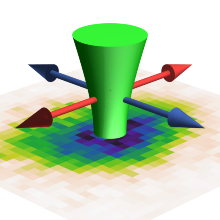Imagine relaxing in your rowboat on a nice lake - made up of a superfluid. Your paddles move frictionless in the superfluid, which means they do not work at all and you are stuck. Yet, out of sheer panic, you paddle faster until at some point the paddle reaches the critical velocity. There, superfluidity breaks down and the boat starts to move, finally. If you happen to try this with a dipolar superfluid, you would notice that you can move in one direction, while there is still frictionless flow in the one perpendicular to it.
Although this sounds like a twisted sci-fi movie, such unusual behavior was recently realized in our lab with ultra-cold magnetic atoms. In a first step, we prepared a Bose-Einstein condensate (BEC) of magnetic dysprosium atoms. Then, in analogy to the paddle, a laser beam was moved through the atomic cloud to measure its superfluid behavior. By recording the temperature of the BEC after stirring it with the laser beam, we found a difference in the critical velocity, comparing directions perpendicular and parallel to the magnetic field. At this velocity of the moving laser, superfluidity breaks down and the cloud starts to heat. This behavior is in full agreement with computer simulations.
This remarkable result is the first measurement of transport behavior on a BEC with magnetic atoms. It directly reveals the connection of the underlying dipolar interaction between the atoms and macroscopic quantum properties, such as superfluidity.


